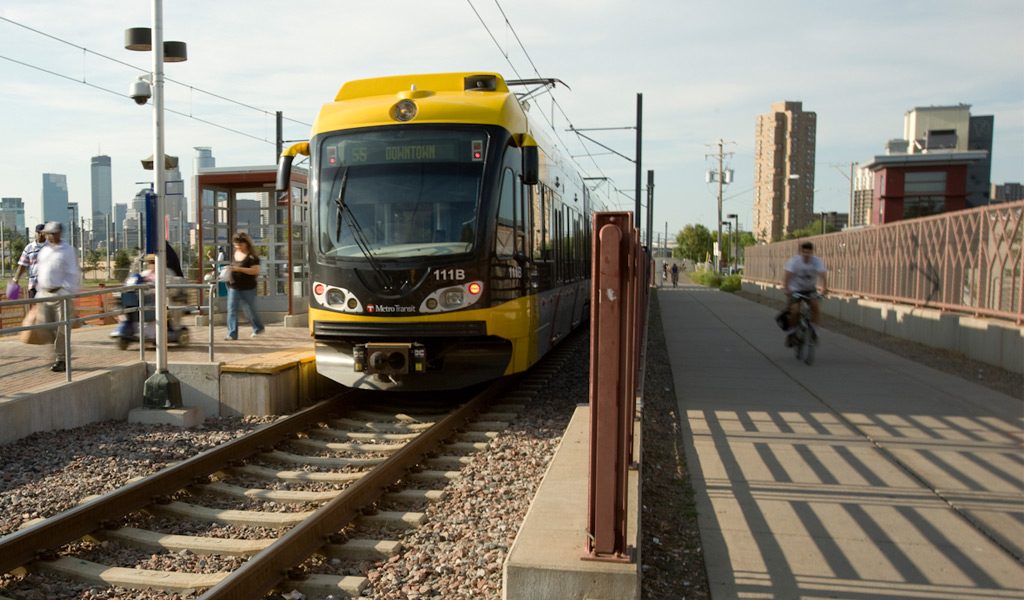
How the arts create a sense of place in St. Paul
A restaurant on a construction-filled street is doing more than serving up Vietnamese food in St. Paul. It’s quickly becoming a case study for how the arts can create a sense of place.
Mai Village sits squarely at the heart of the bustling five-block area known as “Little Mekong” near Minnesota’s State Capitol. Though a local favorite, owners feared that patrons would be scared off by the construction that will make its corner a prominent stop on the Central Corridor light rail line eventually connecting the Twin Cities.
But a partnership with Irrigate, which enlists the city’s cultural community in making positive physical, economic and social impacts, is helping prevent that scenario. It brought a local cabaret artist, Mira Kehoe, to perform her “Jazz on the Line” show in the restaurant as an experiment to increase dinner patronage. It worked. Mai Village’s owners say they saw a 40 to 50 percent increase in revenue on nights Kehoe performed and are now contracting with her to perform into the future. The restaurant also is hosting other groups like Happy Cabaret and Soullections, which perform live music. RELATED LINK

“St. Paul residents get their say, in a rail line and their future” by Elizabeth R. Miller on Knight Blog
The performances are examples of how local artists are working with businesses to boost the community’s cultural vibrancy and bring shoppers back to the avenue during construction. Knight’s Vice President/Arts, Dennis Scholl, explains this is creative placemaking. He defines it as “art, culture and creativity, expressed powerfully through a specific place, that can create vibrancy,” and it’s already finding a home in St. Paul. Irrigate, a partnership of Springboard for the Arts, the City of St. Paul and Twin Cities LISC, was designed to help further the concept. So far it has trained more than 300 local artists to collaborate with businesses, community groups and organizations. The project was one of the first and largest awards made by ArtPlace America, a collaboration of 10 leading regional and national foundations (including Knight), federal agencies and banks working to accelerate creative placemaking.
Along St. Paul’s Central Corridor there are more than two dozen projects that address pressing issues with the goal of encouraging cultural vitality and fueling economic growth. Along bus stops in Frogtown, which sits adjacent to Little Mekong, sculptor Gita Ghei installed trees in pots made by teens. Downtown, two local artists painted the image of a traditional East Asian garden on a mural outside an Asian and Mexican fusion restaurant. Over a three-year period, Irrigate will cultivate between 30 and 50 similar projects. An interactive map shows completed and in progress projects, along with potential sites. The public can also submit ideas.
St. Paul’s arts leaders also hope the area along University Avenue can become a home-base district for the community’s creative industry. The so-called “Creative Enterprise Zone” is envisioned as a place for painters, photographers and designers to take up residency in old industrial buildings and also create shared co-working spaces.
The cultural improvements along the corridor mirror the community’s overall efforts to engage more people in the arts. St. Paul created and launched the now national Community Supported Art program, where much like the similar farm-share program, local artists receive a commission to create “shares” for members of the community to purchase. In return, members of the community receive boxes or portfolios of the artwork in the hopes it will encourage them to become long-term collectors.
It’s now in nearly 30 other communities across the country. Residents love the program because they know the money is going directly to the artists, said Laura Zabel, the executive director at Springboard for the Arts, which took the program national with Knight’s support. Another draw: the program is designed to be an open and self-sustaining program, which can be unusual for the arts.
“We were very intentional and deliberate about being open with the idea and letting our partners take it over in each community,” Zabel said. “What we created was a way to convene people with common interests in the arts so that they could come together, meet each other and support the work of their local artists.”
Creative placemaking is part of Knight Foundation’s strategy in St. Paul. “When people hear the term creative placemaking, I want them to think of St. Paul,” says Knight’s Program Director in St. Paul, Polly Talen. “Because of its ability to help transform communities, creative placemaking has been, and will remain, a central focus of the work happening along the Central Corridor. We look forward to exploring how the intersection of arts and economic development can help strengthen this community.”
By Elizabeth R. Miller, communications associate at Knight Foundation
Recent Content
-
Artsarticle ·
-
Artsarticle ·
-
Artsarticle ·

